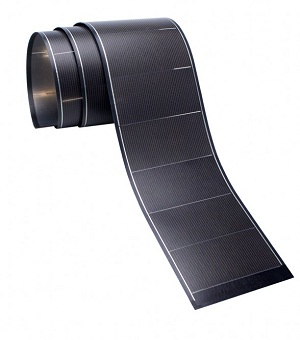Thin-film photovoltaics

Thin-film solar photovoltaics are a class of photovoltaics that are also known as second generation photovoltaics. Thin-film photovoltaics came about as an alternative to silicon-based photovoltaics because the costs of the semiconductors used in thin-films were cheaper than silicon. However, increased production of silicon for solar and other uses has dramatically dropped its cost. That and a subsequent increase in the production of silicon-based photovoltaics have reduced the price of silicon-based photovoltaics, making it harder for thin-film photovoltaics, which are still generally less efficient than silicon photovoltaics.
There are three main types of thin-film photovoltaics: Cadmium Telluride (CdTe): Copper Indium Gallium Selenide (CIGS); and amorphous silicon. Another type of photovoltaics using Gallium Arsenide could be considered thin-film, but are often called multi-junction photovoltaics since they use multiple layers of semiconductors to absorb more light than other PV cells. For a look at major thin-film producers as of July 2012, see the table at the bottom of the page.
The world’s largest producers of thin-film photovoltaics are First Solar, which makes CdTe-based modules, and Solar Frontier, which makes CIGS-based modules. A number of other companies are producing both. But recently a number of companies pursuing success in the thin-film market have folded, including Solyndra, and more recently Abound Solar, which filed for bankruptcy in July 2012, and General Electric, which announced that it would delay completion of its first thin-film photovoltaics manufacturing plant.
While thin-films are not as efficient as the most efficient silicon-based PV cells on the market, which were reaching 24 percent efficiency as of July 2012, they can still improve. First Solar has produced cells that reach 17.5 percent efficiency, though their modules were closer to 14 percent efficiency in July 2012. CIGS maker Stion was producing modules that were close to 13 percent efficient as they ramped up production in 2012, with plans to produce modules up 15 percent efficient. The efficiency level of CIGS could exceed 20 percent, however.
Thin-film photovoltaics, particularly CIGS and amorphous silicon have an advantage over traditional silicon photovoltaics because they can be designed to be flexible. As such they can take on a variety of form factors, like roof tiles, rollable strips of material or even a patch on a backpack or piece of clothing that can produce electricity. They can also be used as building-integrated photovoltaics where they can wrap around the corner of a wall, for instance.
There also is a third-generation of photovoltaic technologies that encompass a larger variety of technologies, which will, and are, result in photovoltaic devices that are microns thick. This class of technologies include nanomaterials, solar inks, solar dyes and organic photovoltaics. However very little third-generation technologies are now available on the market.
|
Major thin-film PV manufacturers by technology (Alphabetical)* |
||
|
CdTe |
CIGS |
Amorphous Silicon |
|
|
Anwell Technologies |
|
|
Arendi |
DayStar Technologies |
Energy Photovoltaics |
|
Calyxo |
Global Solar Energy |
EPOD |
|
Free Energy Europe |
||
|
Longyan Energy Technology |
Honda Soltec |
Dupont |
|
International Solar Electric Technology |
ICP |
|
|
Sichuan Apollo Solar |
IBM |
OptiSolar Tech |
|
Solar Systems & Equipments |
ICP |
PowerFilm Inc. |
|
Willard & Kelsey (WK) Solar |
Miasole |
|
|
|
Nanosolar (printed electronics) |
Sharp Solar |
|
Odersun |
Spectraflex |
|
|
Q-Cells-Solibro |
TerraSolar |
|
|
Solar Frontier (formerly a division of Showa Shell Sekiyu) |
||
|
United Solar Ovonics Jinneng Ltd |
||
|
Sulfurcell |
VHF-Technologies SA |
|
|
Veeco Instruments Inc |
Xunlight Corporation |
|
|
Würth Solar (CISfab) |
|
|
|
Yohkon Energia (CIGS Spanish manufacturer) |
||
|
* Some companies listed here may no longer be producing or are just ramping up production as of July 2012. Please let us know if we’re missing any companies. Information compiled from numerous Web resources. |
||



